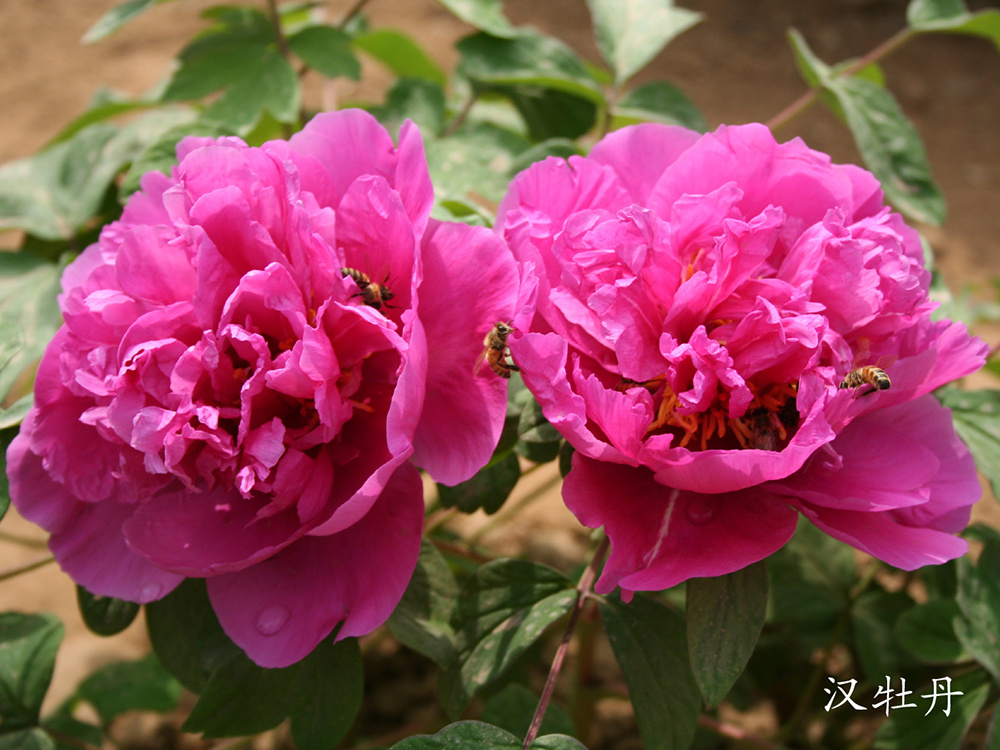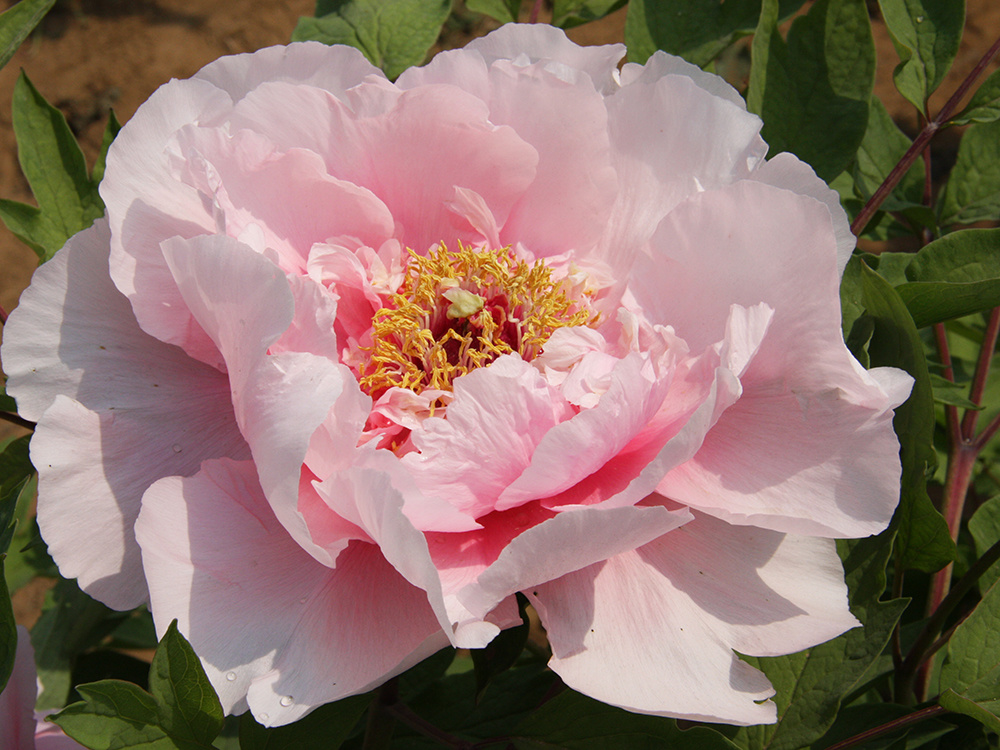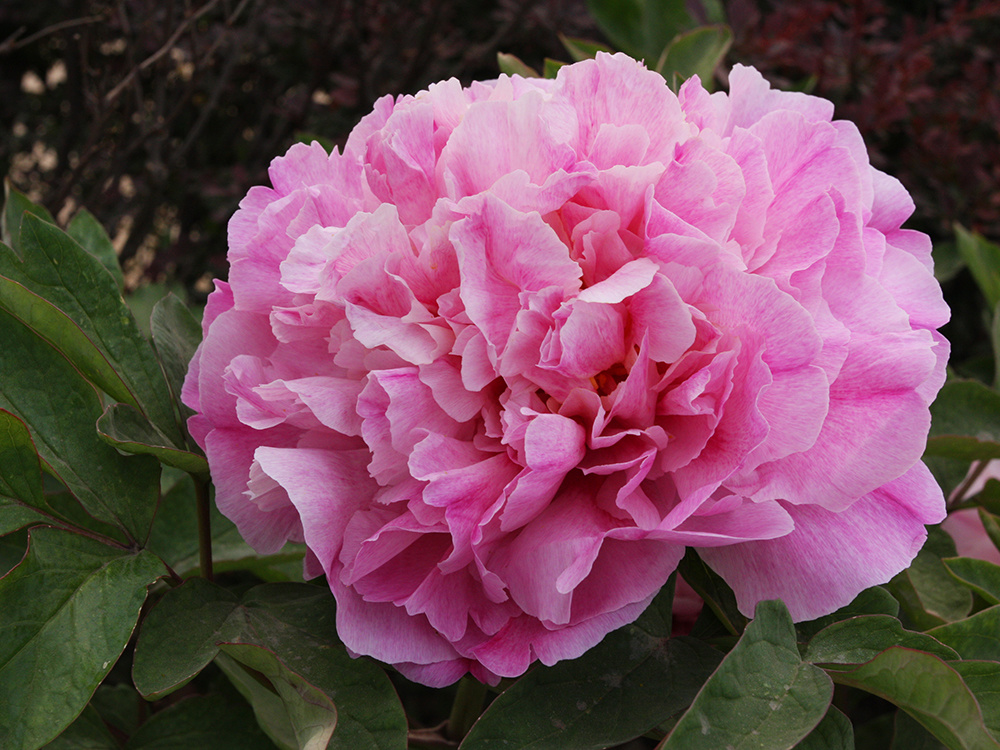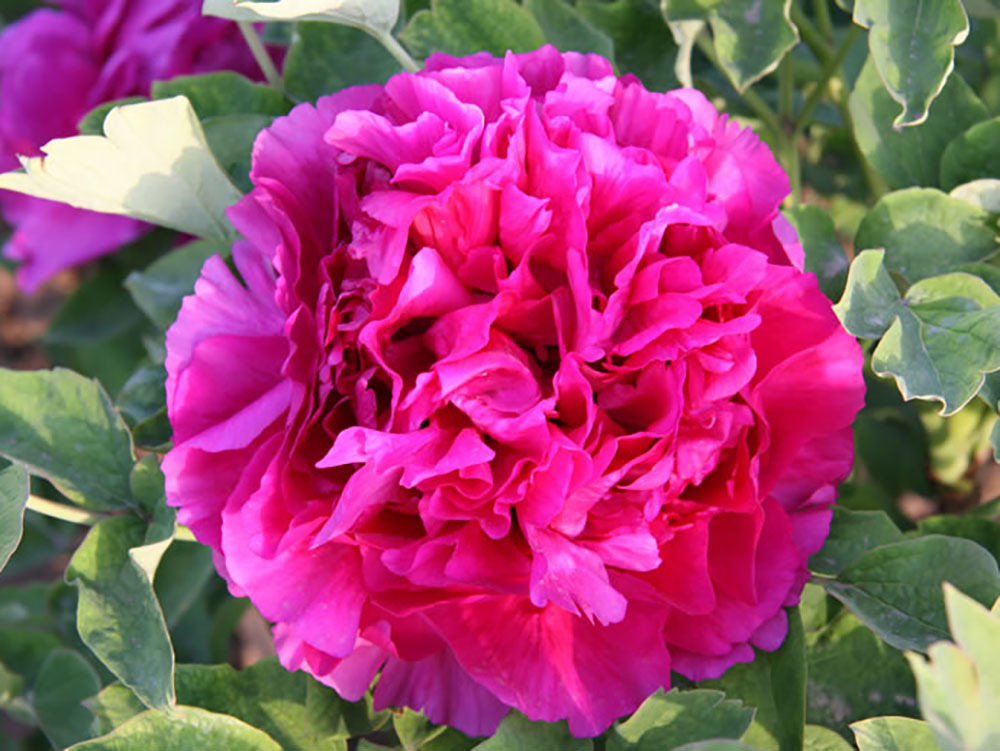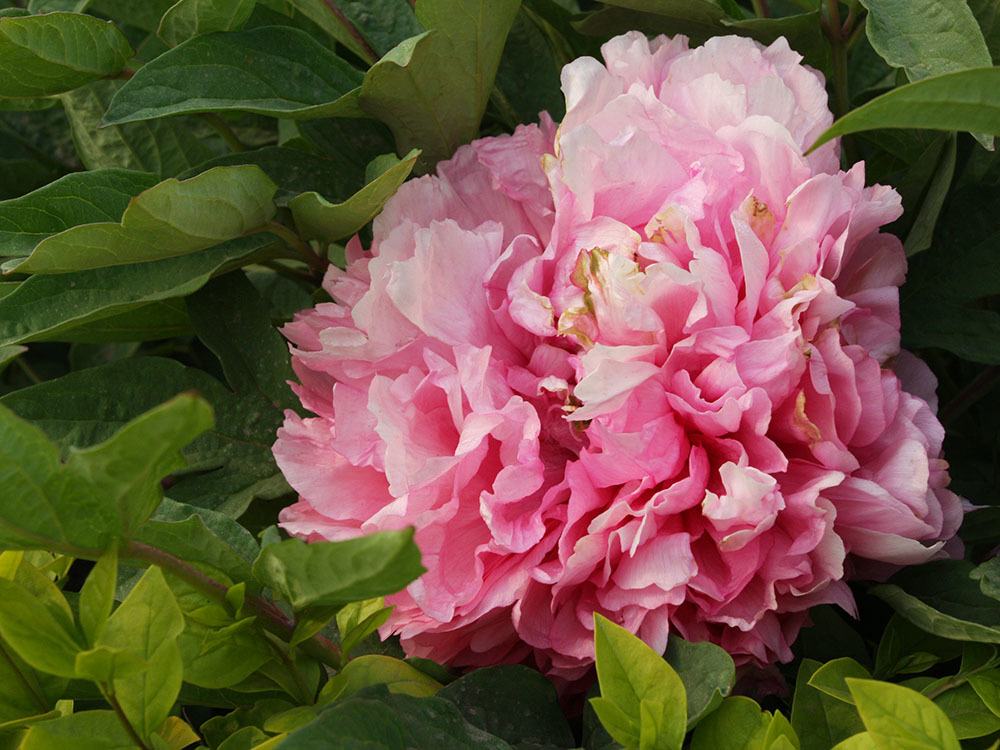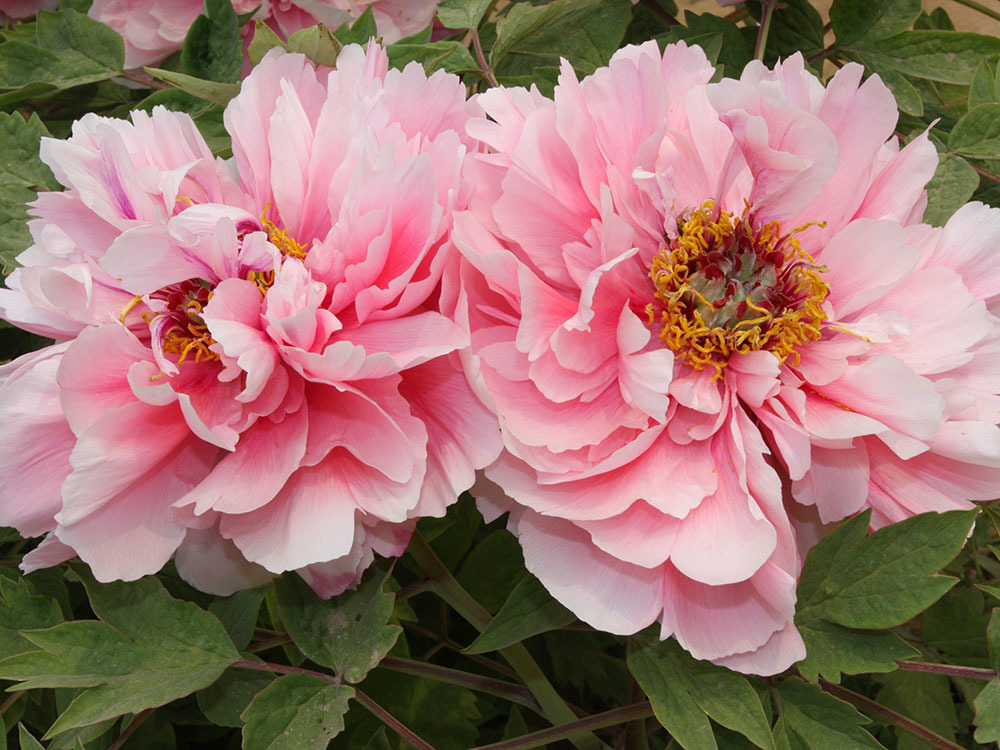Flower Appreciation
Contact Us
E-mail: bxhmd@126.com
Tel: 0086-319-7796393
Address: Han Mudan Garden, Baixiang County, Xingtai City, Hebei Province, China
Peony is an inherent specialty flower in China. It has a history of thousands of years of natural growth and more than 2,000 years of artificial cultivation. Its flowers are large, beautiful in shape, bright in color and fragrant, and have been praised by people in the past dynasties. They have high ornamental and medicinal values. Since the Qin and Han Dynasties, medicinal plants were included in the "Shen Nong’s Herbal Classic", and they have been scattered in various ancient books of the past dynasties. There is no shortage of articles. Formed a peony culture including botany, horticulture, pharmacology, geography, literature, art, folklore and other disciplines, it is an integral part of Chinese national culture and folklore, and a complete body of Chinese national culture Through it, one can gain insight into the general characteristics of Chinese culture, which is the phenomenon of "cultural holography".
Peony culture is compatible with many sciences, and its composition is very extensive, including all cultural fields such as philosophy, religion, literature, art, education, customs, and folk customs. The cultural information provided by peony culture can reflect the basic overview of national culture and conform to the "holographic law" of the universe.
(1) Auspicious and rich culture (2) Aesthetic culture (3) Literary culture (4) Horticulture culture
(5) Tourism culture (6) Local culture (7) Biological culture (8) Pharmacological culture
Peony culture is a part of national culture. Compared with other types of culture, peony culture has its advantages:
Peony culture is the combined product of spiritual civilization and material civilization. Judging from the history of peony development in ancient and modern China and abroad, it is indeed the case.
Peony Culture--Auspicious Wealth
The use of cultural symbols and meanings is a major feature of Chinese traditional culture. Various techniques are often used in Chinese language culture and various art forms, such as metaphor, pictogram, homonym, etc., to express a certain symbol or implication in people's life and thought, and then to express people's and the nation's ideals and wishes , longing and pursuit.
In traditional Chinese culture, the cultural symbolic meaning of flowers has quite rich content. There are no less than a hundred kinds of sign patterns composed of flowers, among which peony flowers are the most, because people love peony. As far as peony is concerned, its flowers are graceful, luxurious, dignified and rich, which arouses people's many associations and derives the associated A series of cultural symbolic meanings form the basic connotation of peony culture.
When the peony blooms, the flowers are blooming like a piece of brocade, resplendent and resplendent. Once in the heyday of the Tang Dynasty, all the people in the country were fascinated by it, and the peony season became a carnival in the capital Chang'an. Since the Tang and Song Dynasties, the peony has become a symbol of auspiciousness, happiness, and prosperity. For thousands of years, generations of Chinese people have been thinking about their own prosperity all the time in the pursuit of a better life. The peony represents the aspirations of the people. Expectation and pursuit, in the minds of the people, the peony is also the embodiment of beauty, a symbol of purity and love. The country is prosperous and prosperous, the family values wealth and safety, and people like happiness and auspiciousness. These characteristics and implications are all contained in the peony! different meanings.
Peony Culture--Artistic Atmosphere and Aesthetic Features
The inner beauty and quality beauty expressed by the peony itself have attracted countless literati and inkmen in the past dynasties. Poetry and prose, as well as various paintings and works of art. Numerous peony poems and poems occupy a place in the history of Chinese literature and constitute the basis of peony literature. The peony poems and essays left by some literary masters in the Tang and Song dynasties and after that still radiate brilliance. Peony poems have a wide range of content. Poets often use things to express their aspirations and use ancient times to describe the present. Many poems are profound in thought, expressing the poet's persistent spiritual pursuit and unique aesthetic taste. knowledge and understanding. Therefore, poets, painters and artists of all dynasties are fond of peonies, and poems, calligraphy and paintings with peony as the theme are widely circulated. The peony-named products, trademarks and peony decorative patterns on various living utensils are too numerous to enumerate. There have always been the most works of chanting, painting and singing peonies. In the "Four Hundred Poems Ode to Peony in Past Dynasties" edited by Yang Maolan, there are 125 poems in the Tang and Five Dynasties, 167 in the Song Dynasty, 27 in the Jin and Yuan Dynasties, 37 in the Ming Dynasty, and 67 in the Qing Dynasty, a total of 419 poems with 203 authors. Its content reflects the customs and hobbies that Peony aroused to the society at that time from various aspects.
Among the many ancient folk songs and modern songs in our country, there are many works based on peony. These peony songs (folk songs) are euphemistic, fresh and graceful. Listening to them makes people radiate love for life and enjoy the spirit of beauty.
In my country's oldest "Book of Songs", there are lyrics with peony and peony as love tokens: "Gift it to peony." ” This peony not only refers to peony, but also refers to peony. Because the peony was unknown at first, it was collectively called "Shaoyao".
Among many modern and modern folk songs, "Hua'er" in Qinghai and Gansu and Henan folk song "Weaving Flower Basket" are the most popular. "Hua'er" is a form of oral singing popular among the people. It combines local customs and customs to express people's love for their hometown and yearning for a better life. And "Weaving Flower Basket" vividly expresses the joy of a group of girls who go up the mountain to pick peonies through beautiful tunes. Listening to his song, it seems to be in the charming pastoral mountain village.
There are also many modern songs praising peonies, among which the most popular one is the episode "Song of Peony" from the movie "Red Peony". The song praises the character of peony, narrates the experience of peony, and gives people a vigorous passion.
As far back as the Southern and Northern Dynasties (550-577), there were records of Yang Zihua painting peonies among painters who took peonies as the theme. In the Tang Dynasty, there were many painters painting peonies. According to Dong Shou's "Guangchuan Painting Postscript", it is recorded that the peonies painted by Bian Luan, a painter of the Tang Dynasty, are wonderful and moist. "The "Peony Picture" painted by Xu Xi during the Five Dynasties and the Southern Tang Dynasty (923-936) is exquisite in brushstrokes and vivid in taste, which is a must. In the Ming Dynasty, Xu Wei painted peonies with splashed ink, which was bold and unrestrained, which was a pioneering work. In the Qing Dynasty, Yun Shouping painted peonies, which are beautiful, elegant and self-contained. In modern times, the famous painter Wang Xuetao once painted a large number of peony paintings, each with different expressions and full of vitality. The peony paintings by Qi Baishi, a master painter, are concise and full of vitality.
The peony's colorful colors, varied flower shapes, refreshing fragrance, and the charm of silky petals on the huge flowers give people a unique natural beauty. The re-creation of poetry, painting and other art forms sublimates the natural beauty of peony, thus showing a richer artistic beauty, and using various art forms to make its image permanent in people's lives. The aesthetic features expressed in the peony culture still need to be further explored and considered in the future to make it more prosperous.
Peony horticultural culture
The application and development of peony cultivation is inseparable from science and technology, which involves biology, breeding, pharmacology, horticulture, gardening, economics and many other disciplines. Among them, the content of flower horticulture is the most abundant.
The earliest application of peony was mainly medicinal. Today, peony root bark - "Dan bark" still plays an important role in Chinese herbal medicine. The earliest record of peonies as medicinal plants should be "Shen Nong's Materia Medica". The book was written by a person named "Shen Nong" in Qin and Han Dynasties, and the exact date is unknown.
For thousands of years, the peony has been able to be in various poses and with different expressions, and its reputation has spread far and wide. The extremely important reason is the biological characteristics of peony that are prone to variation. The basic conditions for the variation of peonies from the mountains to the gardens and courtyards, and from wild to cultivated, are a qualitative leap in the history of peony development and culture. Changes in various environmental conditions have caused major changes in the biological characteristics of peonies. The flowers have changed from single petals and semi-double petals to double petals, and even Taige flowers appear; the flower colors have also evolved from a few colors to nine. Large color system; varieties from dozens to thousands. After the long-term practice of flower farmers and the in-depth summary of horticulturalists, a complete set of peony cultivation techniques has been gradually formed. Among them, grafting peony flowers with peony roots and flower dyeing methods are the creations of the Chinese working people and important contributions to flower horticulture.
"Luoyang Peonies" written by Ouyang Xiu, a writer in the Song Dynasty, not only records the distribution of peonies across the country at that time, the reasons why Luoyang peonies became famous, records excellent varieties, but also describes the origin of peony varieties, naming principles, breeding methods, The law of evolution, cultivation techniques, and folk customs of peony appreciation, etc., the creative method of combining peony cultivation and peony culture is also an important feature of ancient Huaqi horticultural works. This is the crystallization of the wisdom of the working people of all ages, a precious cultural heritage, and an important document for future research on the history of Chinese peony cultivation and cultural history.
Since Tang Xuanzong ordered Song Shanfu to plant thousands of peonies in Lishan and create a peony garden, the activities of introducing and planting peonies, cultivating new varieties, collecting famous products from various places to build peony gardens in various places in China have been going on for a long time. The prosperity has not declined, and even in the central part of Gansu Province, the farmhouse peony gardens established by farmers of Han, Hui, Dongxiang and other ethnic groups are dotted all over, forming a beautiful landscape full of Longyuan characteristics.
Peony Culture -- Tourist Atmosphere
The Chinese peonies are enjoying the prosperity and bathing in the spring brilliance. The grand occasion is unprecedented, and there are many places where peonies are produced. A grand peony flower fair is held every year to promote peony culture. At that time, the flower city was empty for thousands of people, and the people who watched the flowers crowded shoulder to shoulder, laughing and singing, the colorful flowers, and the intoxicated people flowed into a sea of joy. The blooming of peony brings the appreciation of thousands of people. As a result, an atmosphere of traveling abroad because of peonies was formed, which continued to become the tourism of peony culture. This is indeed the case from the history of peony development at all times and in all over the world. It can be said that "when the fortune of the country is prosperous, the fortune of flowers will be prosperous". History once proved this profound philosophy.
Peony local culture——“Bring it to you with flowers”
Peonies can reflect different local flavors in different regions.
Known as the "Land of Guangwu Zhongxing, the Hometown of Peonies in the Han Dynasty", Baixiang, Hebei Province has seven Han Dynasty peonies that can be called "living fossils of peony in the world". Every year before and after Grain Rain, the fragrance spits out the pistils, and the fragrance floats for miles.
Around the cultural history of peony in the Han Dynasty for more than two thousand years, a large number of beautiful legends and folk stories have been produced: One day at dawn, the monks suddenly felt the fragrance, and in amazement, they saw a pair of boys and girls in red clothes. Clothes, floated into the temple, chased after them, and fell into the steps, peonies and peonies came out, causing a sensation in the four villages, people rushed to watch, and fairies and fairies entered the ground to become flowers, men made peony, women turned into peonies. Word of mouth spread like wildfire, word of mouth, women and children all know. When Wang Mang usurped the Han Dynasty and the world was in chaos, Wang Lang, the diviner, proclaimed himself emperor of Handan in the name of Liu Ziyu. Once, Liu Xiu was chased and killed by Wang Lang's army alone to the south of the city. He panicked and hid among the blooming peonies in the Amitabha Temple in Beihao Village, and escaped the disaster. In order to thank Peony for saving her life, a poem was written on the broken wall: "King Xiao took refuge in Huangzhuang, and the wells and temples were not very desolate." Only a few peonies are loyal to the king." Because the peony in Baixiang saved the life of Liu Xiu, Emperor Guangwu of the Han Dynasty, the name of Han Peony was derived from it.
What is even more miraculous is that: when the emperor passed away, the peony of the Han Dynasty used white flowers as a prophet; The five unique features of Han Peony are different from other domestic peonies:
One, the age is long. It has been recorded in the Han Dynasty for more than 2,000 years.
Two, the same plant has different flowers. A Han peony can produce flowers of different shapes at the same time.
3. Flowers love their homeland and cannot live in other places.
Four, the unsolvable mystery--the death of the emperor is a sign of white flowers.
Five, known as aura—— when the flowers are in full bloom, the years are full, but when the flowers are declining, the years are short”
To this day, Han peony still perceives many major events in the Republic with her flower color and number of flower branches, and the common people's wind of viewing flowers and asking about things is still very popular.
Biological characteristics of peony
During the whole life (live) process of peony, there are two periodic changes. One is the change of the life cycle; the other is the change of the annual cycle.
Like other higher plants, the life cycle of the peony changes in stages. Life begins with the formation of the embryo and ends with the death of the plant. In the middle, it needs to go through the embryonic (seed to bud) stage, the juvenile stage, the weak stage, the prime stage and the old stage. That is to say, "Peony seedlings are young at two years old, weak at four years old, strong at six years old, and strong at eight years old." “For those who are planted separately, they are weak at one year, strong at two years, ai at eight years, old at twelve years, and old at fifteen years. "However, 15 years after the peony grows and blooms, it does not mean that the entire life cycle of the peony is coming to an end, but that its vigorous flowering has weakened. If flower farmers can carefully cultivate and strengthen management, it is common for peonies to grow for four to fifty years or even more than a hundred years. The change of the peony cycle can be divided into two different periods according to its activity rules, namely the growth and development period (including reproduction) and the relative dormancy period. The growth and development period is from the germination of scale buds in February to the withered leaves at the end of October; the relative dormancy period is from when the leaves are withered to the buds germinate in the next spring.
Peony medicinal culture
Peony is an inherent specialty flower in China, with a history of thousands of years of natural growth and more than 2,000 years of artificial cultivation. Its flowers are large, beautiful in shape, bright in color and fragrant, and have been praised by people in the past dynasties. They have high ornamental and medicinal values. The origin of peony culture, if peony enters poetry from "Book of Songs", is about 3,000 years ago. history. In the Qin and Han Dynasties, peony was recorded in "Shen Nong's Herbal Classic" as a medicinal plant, and peony has entered pharmacology.
[Pharmacological action and clinical application of Cortex Moutan]
1. Anti-inflammatory and anti-bacterial effects: Paeonol, the main component of peony, can inhibit the swelling of the feet of rats caused by dextran, acetic acid and carrageenan; Or increased capillary permeability in guinea pig skin. Modified Rhubarb Mudanpi Decoction is applied clinically to treat appendicitis. In vitro test, its decoction has antibacterial effect on more than ten kinds of bacteria, and the active ingredient is gallic acid.
2. The effect on the central nervous system: Paeonol has analgesic effect on mice by intragastric administration, intraperitoneal injection or oral administration can reduce the spontaneous activity of mice, and significantly prolong the sleep time of mice induced by cyclamate sodium; it can also obviously resist Convulsions induced by pentylenetetrazol, strychnine, nicotine, and electric shock. Compatible with other medicines clinically, it is often used for amenorrhea dysmenorrhea and pain caused by falls.
3. Antihypertensive effect: paeonol decoction or paeonol has antihypertensive effect on anesthetized dogs, rats or renal hypertensive dogs. Clinically, single Moutan cortex has also been tried to treat hypertension, and it has a short-term effect.
4. Clinically, its decoction is often used to treat acute and chronic appendicitis, bacillary dysentery, and allergic rhinitis.
[Selected Literature]
"Pearl Sac": The peony is the essence of the world and the head of the group of flowers. The leaf is yang, and it is the master of hair; the flower is yin, and it becomes fruit. Dan is red, and fire is also. Therefore, it can purify the yin cell.
"Compendium of Materia Medica": Red flowers are beneficial, white flowers are nourishing, and people rarely understand it, so they should be separated.
"Sichuan Traditional Chinese Medicine Chronicle": Treat women's irregular menstruation and abdominal pain during menstruation.
"Compilation of Commonly Used Herbal Medicines in the Folk": Regulating menstruation and activating blood circulation.



